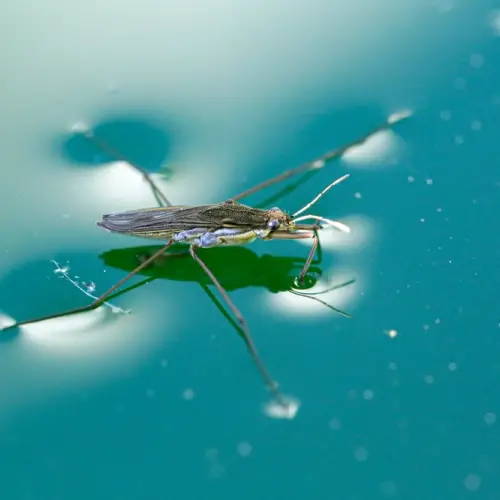
Surface tension is a physical property of liquids that refers to the force acting on the surface of the liquid and which tends to reduce the surface area to the minimum possible. This property is the result of the cohesive forces between the molecules of the fluid.
This property allows some objects to float on the surface of a liquid, such as aquatic insects that can walk on water.
Surface tension also plays an important role in phenomena such as capillarity, that is, the ability of a liquid to rise against gravity through a narrow tube.
As an example, the surface tension of water is one of the highest among common liquids. The typical value of the surface tension of water at 20 degrees Celsius is about 72 millinewtons per meter (mN/m) or 72 dyn/cm.
How does it work?
 In a liquid, molecules inside are surrounded and attracted in all directions by other adjacent molecules. However, at the surface of the liquid, molecules are only surrounded and attracted inward and to the sides, creating a net inward force. This net force is responsible for surface tension.
In a liquid, molecules inside are surrounded and attracted in all directions by other adjacent molecules. However, at the surface of the liquid, molecules are only surrounded and attracted inward and to the sides, creating a net inward force. This net force is responsible for surface tension.
Due to surface tension, liquid droplets tend to have a spherical shape, since this shape minimizes the surface area exposed to the environment.
Surface tension formula
The mathematical formula for calculating the surface tension of a liquid is based on the relationship between the force acting on the surface of the liquid and the perimeter of the surface. The formula is as follows:
T = F / L
Where:
- T represents the surface tension of the liquid.
- F is the force acting on the surface of the liquid.
- L is the perimeter of the liquid surface.
Surface tension is expressed in units of force per unit length, such as newton per meter (N/m), dyn/cm, or the equivalent joule per square meter (J/m²).
It is important to note that this formula is a basic, simplified representation of surface tension. In more complex situations or with irregular surface shapes, more complex equations may be required to accurately calculate surface tension.
Examples of surface tension
Here are some examples that illustrate surface tension in different situations of our daily lives and in natural phenomena:
Example 1: Water drops
When a water droplet forms, it tends to take on a spherical shape due to surface tension. The water molecules on the surface of the droplet experience a mutual attraction, creating a kind of "skin" that minimizes the surface area exposed to the air. This tendency to minimize surface area is the reason why water droplets take on a spherical shape, since the sphere is the geometric shape that has the smallest surface area for a given volume.
This phenomenon is observable when small amounts of water are spilled on a non-absorbent surface, such as a plant leaf or a waterproof cloth.
Example 2: Insects on water
 Some insects, such as water bugs, can walk on the surface of water without sinking thanks to surface tension. The legs of these insects have a special structure that distributes their weight so that they do not break the surface of the water. Surface tension acts as a kind of elastic membrane that supports the insects, allowing them to move on the water without falling.
Some insects, such as water bugs, can walk on the surface of water without sinking thanks to surface tension. The legs of these insects have a special structure that distributes their weight so that they do not break the surface of the water. Surface tension acts as a kind of elastic membrane that supports the insects, allowing them to move on the water without falling.
This phenomenon is possible because the cohesive forces between water molecules on the surface are strong enough to support the weight of the insects.
Example 3: Capillarity in plants
Capillarity is a phenomenon closely related to surface tension that is observed in the ascent of water through the capillaries of plants. Water molecules adhere to the vessel walls (adhesion force) and attract each other (cohesion force), allowing water to rise through these microscopic tubes against the force of gravity.
This process is essential for the transport of water and nutrients from the roots to the leaves, thus allowing the survival of the plants.
Example 4: Soap bubbles
 Soap bubbles are another classic example of surface tension in action. When a bubble is blown, the air inside it pushes outward, while the surface tension of the soap film holds it together. The bubble takes on a spherical shape because surface tension attempts to reduce energy by minimizing surface area.
Soap bubbles are another classic example of surface tension in action. When a bubble is blown, the air inside it pushes outward, while the surface tension of the soap film holds it together. The bubble takes on a spherical shape because surface tension attempts to reduce energy by minimizing surface area.
This property allows the bubbles to be so flexible and resistant, although also fragile, since a small disturbance can break the film.
Example 5: Tear formation
The surface tension of the tear fluid in our eyes is responsible for the formation of tear drops. This phenomenon allows the tears to remain in the form of drops, rather than spreading over the entire surface of the eye.
The cohesion between water molecules in the tear fluid maintains the integrity of the tear until its weight exceeds the force of surface tension, at which point the tear falls.
Example 6: Flowers floating in water
 Some flowers, such as lotus flowers, float on the surface of water due to surface tension. Air cells within the flower structure, combined with the surface tension of the water, allow the flower to stay afloat.
Some flowers, such as lotus flowers, float on the surface of water due to surface tension. Air cells within the flower structure, combined with the surface tension of the water, allow the flower to stay afloat.
This is crucial for the survival of these plants, as it allows their leaves to receive direct sunlight and carry out photosynthesis, while their roots remain submerged.
Example 7: Floating needles and clips
A needle or metal paper clip can float on the surface of water if carefully placed. Although these objects are denser than water and should therefore sink, the surface tension of water is strong enough to support the weight of the object if carefully placed without breaking the surface.
This phenomenon demonstrates how surface tension can temporarily overcome the force of gravity on small objects.
Example 8: Effect of surface tension on cleaning
Detergents work by decreasing the surface tension of water, allowing water to wet surfaces better and penetrate fabrics or floors more easily.
This improves the water's ability to remove dirt and grease, as these substances are repelled by the high surface tension of pure water. When the surface tension is reduced, the water can mix better with grease and oil, making it easier to remove them.
Example 9: Tears of wine
 The phenomenon known as "wine tears" occurs when the alcohol in a wine evaporates more quickly than the water. The surface tension of the remaining water is greater, causing droplets to form on the walls of the glass. These droplets collect and then fall, creating a visual effect known as wine tears or legs.
The phenomenon known as "wine tears" occurs when the alcohol in a wine evaporates more quickly than the water. The surface tension of the remaining water is greater, causing droplets to form on the walls of the glass. These droplets collect and then fall, creating a visual effect known as wine tears or legs.
This phenomenon is related to both evaporation and surface tension and is indicative of the alcohol and glycerol content of the wine.
Measurement techniques
Various methods are used to measure it, including the hanging drop method, the Wilhelmy plate and the Du Noüy ring technique.
Hanging drop method
This method is based on the analysis of the shape of a drop of liquid hanging from a needle or capillary tube. As the drop hangs, gravity pulls downward, while surface tension acts to hold the drop together. The resulting shape of the drop is a function of surface tension and gravitational forces. By using equations that relate the drop profile to surface tension, the value of this property can be calculated.
This method is accurate and is frequently used in laboratories to measure liquids with different properties.
Wilhelmy plate
In this method, a sheet or plate of a material, usually glass or platinum, is dipped vertically into the liquid whose surface tension is to be measured. The surface tension acts on the plate, and the force measured when attempting to remove it from the liquid is used to calculate the surface tension.
The advantage of this method is its simplicity and the ability to measure both the surface tension and surface energy of solids.
Du Noüy ring technique
This method involves a thin wire ring, which is dipped into the liquid and then slowly raised. Surface tension acts on the ring, and the force required to separate it from the liquid surface is directly proportional to the surface tension.
This method is popular for its ease of use and ability to measure the surface tension of liquids quickly.
Other techniques
In addition to these methods, there are other techniques such as the rotating drop method and the ascending capillary method, which also allow surface tension to be measured in different contexts and with different levels of precision.
Simple experiment
 Here is a simple experiment to demonstrate the surface tension of water using common materials:
Here is a simple experiment to demonstrate the surface tension of water using common materials:
Materials needed:
- A transparent container (can be a glass or a cup)
- Water
- A metal clip
- Absorbent paper (for example, a piece of kitchen paper)
Steps to follow:
- Fill the container with water to the brim.
- Place the metal clip carefully on the surface of the water. Observe how the clip floats due to the surface tension of the water.
- Take a piece of absorbent paper and place it on the surface of the water, touching the clip.
- Watch what happens: the paper towel will instantly become wet while the paper clip is still floating. This happens because the water is attracted to the fibers of the paper towel, breaking the surface tension and allowing the water to wet the paper.
This experiment demonstrates how the surface tension of water allows lightweight objects, such as a paper clip, to float on its surface and how surface tension is broken when water comes into contact with a material that can absorb water, such as absorbent paper.